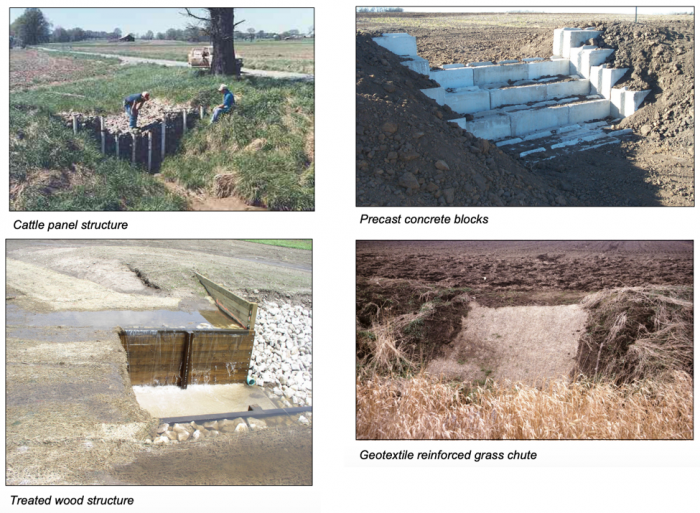
Open drainage ditches are a long-standing, reliable, and natural method of draining and diverting water from low-lying areas or the sides of roads. Ditches can also help to channel water from distant sources towards fields for more innovative plant irrigation.
However, there are many cases where ditches are left unmaintained on a piece of property or rural roads. Eventually, residents of the community often end up bearing the brunt of eroding drainage ditches. Depending on the debris and degree of erosion, ditches can even turn into a sinkhole and cause significant damage to backyards.
If you face problems with inherited drainage ditches on your property, you have options open to help you stop erosion and divert a drainage ditch. Instead of filling in eroding ditches, there are smart ditch erosion control methods you can use to maintain their safety and function.
What are Ditches Used For?
Ditches are a very deliberate construction and agriculture design strategy. Their specific functions differ based on where they’re dug and why.
Some ditches, for example, look like streams or wetlands. Others might exist at the side of rural roads, meant to divert water away from roads and protect the integrity of the roadway.
Whatever their purpose, no engineer expects that ditches will forever remain stable. Banks eventually erode, ditches eventually fill in, and drainage eventually becomes interrupted by shifting slopes and vegetation.
In other words, part of the effectiveness of ditches depends on how frequently they’re maintained. A constructed ditch will respond to changes like:
- Increased water flow and volume
- Blocked channels
- Increased sediment load (due to other eroding gullies and slopes that deposit within ditches)
- Removed vegetation, which destabilizes soil, especially on slopes
A stable ditch and an unstable ditch are very distinct in physical features. An unstable ditch has gravel and sediment collected around it. Depending on where it’s cut into a hill or a slope, there may be large rocks, collapsing roadways, and disruptive vegetation growing into and around it. The force of erosion can then cause a wide gully to form and disrupt more of the surrounding area.
Ditches are important to modern development for:
- Protecting roadways by guiding water along the ditch, away from the road, which preserves the stability of the road subgrade
- Protecting water quality by diverting flow and volume into nearby streams and lakes
- Maintaining a more effective form of drainage than storm sewers. Ditches can be vegetated, which slows down the flow rate of water, which then slows down eroded soil particles. Water can more effectively penetrate nearby soil and allow some of the debris and pollutants to settle out before hitting streams and lakes
- Acting as a debris buffer between planned unit developments (residential homes) and landslide-prone open space uplands. Wide benches or ditches catch fluid debris and stop it from impact structures
What Triggers Ditch Erosion?
Ditch erosion comes in all shapes and forms, but some erosion-triggered issues recur frequently.
A minor bank can erode into a ditch. With enough time and a failure to maintain or upkeep the ditch, an eroding side slope can turn into a major bank undercut. Look for specific signs of ditch erosion, such as:
- A headcut — Eroded deep channel, abrupt (vertical) drop in channel bottom, small waterfalls in ditch
- An incision (channel deepening) — Channel cut deeper, steep side slopes
- Standing water in upland ditch — Stagnant water, ditch not draining, blockages in ditch, not enough of a drop
- Permanently flowing ditch — Ditch rarely, if ever, dries out, with flowing water
- Damaged culvert — Crushed culvert ends, corrosion, other damage
- Water flowing under and bypassing culvert — Water is cutting and flowing under the culvert
- Blocked culvert — Collected rock, gravel, branches, trash trapped in and around culvert, fallen trees stuck in ditch, dam or dam-building activity by other animals, ponded water collected, water flow changed around obstacles
- Failure of vegetation to take root around ditch — Soils eroding and visible, water pooling, may be flowing but also could be stagnant
Ongoing Maintenance for Ditches
Routine maintenance is one of the most effective ways to ensure that a ditch doesn’t erode. However, routine and non-routine maintenance is only useful if the constructed ditch doesn’t have weaknesses itself. An interceptor ditch, for example, may not be paved, and this makes it susceptible to erosion.
For example, in this case, the design of the ditch and the materials used (or not used) that caused the erosion and failure of the ditch.
Technicians that perform routine maintenance have a few options to reduce erosion damage to ditches.
- Disposing of ditch spoils: If left on-site within the ditch excavated soil and vegetation can erode back into the ditch and wash downstream. Use sediment control structures around temporary spoils.
- Correcting sediment buildup: Over time, ditches will fill with sediment, rock, and other debris. This significantly slows down water flow rate, and you may risk changing the flow capacity of a ditch when you’re excavating large amounts of debris. In turn, this increases erosion. It’s a good idea to dispose of sediment in an ongoing manner, instead of allowing buildup.
- Unblocking culverts and using erosion controls: Blocked culverts can trigger ditch erosion, but unblocking these culverts also risks disturbing nearby soils. Frequent and routine culvert checks can stop blocked culverts. When unblocking a culvert, you should install erosion controls like a headwall, apron, or riprap.
How to Stop a Ditch From Eroding
Before you address an eroding ditch directly, consider the rest of your land or property — are there small rills and gullies nearby? Eventually, these erosion-triggered land formations will degrade, widen, and erode your ditch. It’s a good idea to first address any gully, rill, or slope erosion, as a form of preventative erosion control for ditches.
There are several solutions to help with erosion control for ditches, however. All techniques generally fall under one of these four categories.
1) Use Rock Weirs and Flumes
Rock weirs are small, dam-like structures that slow down the flow of water in a ditch. It tempers the flow and releases water in a more controlled manner. A series of rock weirs can help prevent erosion in ditches within gently inclined slopes.
For steep slopes, however, it’s best to use rock flumes. These are chute-like structures with rocks lining the bottom and side of the chute. The rocks extend a little higher along the sides than the water flow, to protect the soil around the ditch from sudden splashes.
2) Use Grade Stabilization Structures
Grade stabilization structures will help you address cracks around your ditch, as well as the gullies and rills that lead toward it. Specifically, if you have a problem with washout on your property, grade stabilization structures are the right solution.
The combination of cattle panel structures, treated wood structures, precast concrete block structures, and geotextile reinforced grass structures can help provide a place for water to move from your field and down into a stream or ditch.
Each type of grade stabilization structure option has its own benefits and cost budget.
Treated wood structures, for example, are a little more expensive because you’ll need a combination of treated wood, concrete, and riprap. The trade-off is that most of it can be installed by hand, so you won’t need extensive equipment as you would if you chose to install precast concrete blocks.
3) Embrace Bank Revegetation
A more natural (yet more labor-intensive) option to stop a ditch from eroding is to use bank revegetation.
The entire aim of ditches is to divert water, so it seems as though erosion will occur naturally at some point. However, using seedlings along a bank and adjacent to a ditch, or planting cuttings along this area can reduce erosion and stabilize the physical structure of the bank.
Four bank revegetation techniques that prove to be very effective natural ditch erosion techniques:
- Seeding — Seeding is the application of vegetative and grass seeds to slopes and banks. They should be used together with other planting techniques. Once the grass sprouts, it protects the soil’s surface from runoff and wind erosion.
- Live staking — The use of dormant wood cuttings inserted into the ground. These “dormant” wood planks then create a root mass that binds soil particles together. It’s an inexpensive, but long-term, ditch erosion control method.
- Streamside fencing — This is a method of erosion control that is more about protection than active revegetation. Streamside fencing keeps cattle and other grazing animals away from the banks of a ditch, and so allows vegetation to establish itself and protect the bank.
- Container or rootstock planting — Both live staking and seeding call for development and germination time. This is pre-rooted plant material that establishes quickly. Planting is most effective when done in the spring.
Bank revegetation techniques are only as effective as the plant species you choose. They should match the conditions you’re planting in. Certain species will only grow and thrive, providing the protection you need in specific conditions.
Also, keep in mind that you will need to tend to these plantings and ensure they don’t become part of the debris, the spoils, or the blockage in a culvert.
4) Deploy Bioengineering Techniques
Bioengineering techniques address a lot more than just erosion or bank stabilization. The combination of solutions enhance slope stability, control sediment, and maintain biodiversity along a ditch.
These are protective techniques, such as riprap, together with vegetative or wood cuttings that provide stability.
Depending on the solution you use, you will have to do much less maintenance than revegetation. However, bio-engineered solutions are more expensive upfront.
- Wattles: Wattles help to protect the bank from runoff. These are bundles of live cuttings staked into the banks. Wattles protect cuttings and allow them to take root and stabilize the bank.
- Fiber/Vegetated rolls: Made of coconut fiber and bound together with twine. It’s best for providing temporary protection on slopes leading to ditches. Rolls are flexible, easy to install, and mold to the bumps and curves on a slope. Furthermore, there is little site disturbance when you lay them down.
- Vegetated geogrids: These are used together with horizontal alternating layers of soil and live branches (brush layers) to provide a double layer of protection. The technique calls for natural or synthetic geotextiles wrapped around exposed soil between brush layers.
Bioengineering techniques are also useful because they work well with rock revetments such as riprap. Ditches with high-velocity flows or unstable bank toes can benefit from these combinations.
Conclusion
Towns and municipalities often construct ditches with particular uses in mind. They’re perfect for drainage, irrigation diversion, and stabilization for roadways and slopes.
However, their connection to larger streams and more significant waterways is exactly why they need erosion protection. Ditches encourage the movement of large volumes of flowing water, so maintenance and monitoring is a must.
If you’re trying to revamp an eroded ditch or prevent surficial failures, contact Granite Seed today.
As an industry leader for projects dealing with erosion control, revegetation, and wildfire and mining disturbance reclamation, our range of products address and restore even the most complex land reclamation projects.
We specialize in working with commercial and government contractors around the world. Learn more about Granite Seed’s projects or make an inquiry with our team today!




